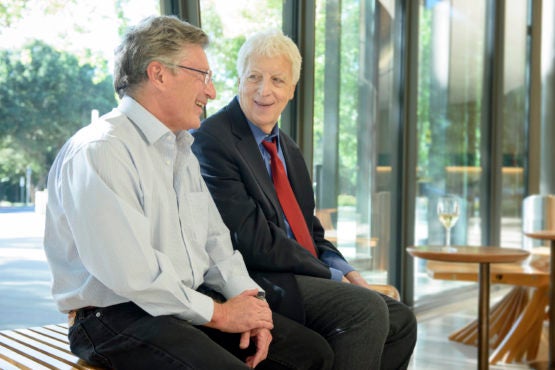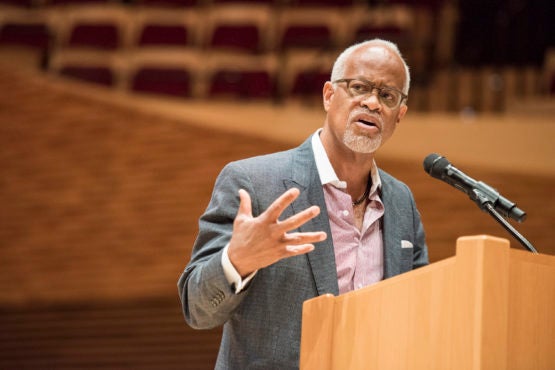Senate pays tribute to John Etchemendy with address on higher education, hears report on Stanford Arts
Speakers at the May 25 meeting included special guest Jonathan R. Cole, a professor at Columbia University; Harry J. Elam, Jr., vice president for the arts; Alexander Nemerov, chair of art and art history; and Stephen Sano, professor (teaching) of music.
The Faculty Senate chose the elegant Bing Concert Hall as the setting for its tribute to John Etchemendy, who stepped down as provost on Jan. 31 after 16 years in the position.

Former Stanford Provost John Etchemendy shares a moment with Professor Jonathan Cole of Columbia University at the reception that followed the Faculty Senate meeting. Cole addressed the senate in a tribute to Etchemendy. (Image credit: L.A. Cicero)
To honor Etchemendy, the senate invited Professor Jonathan R. Cole of Columbia University to deliver an address. Cole, former provost and dean of faculties at Columbia, began his address – which focused on the strengths and challenges facing research universities today – by praising Etchemendy, who sat in the audience.
“If there is a Hall of Fame for university provosts, ‘Etch’ is surely a first-ballot selection,” said Cole, author of The Great American University: Its Rise to Preeminence, Its Indispensable National Role, Why It Must be Protected and Toward a More Perfect University.
In a wide-ranging address, Cole discussed topics that included a proposal to create academic leagues and knowledge communities with the aid of new technologies, and the need to reconstruct the university-government compact.
He also presented a list of the attributes and experiences every university should provide students, including “a skeptical discontent with the present, informed by a sense of the past,” and a willingness to imagine experience from perspectives other than their own.
“For me, a superior undergraduate education should challenge students’ biases, presuppositions and beliefs,” Cole said.
Etchemendy, Stanford’s longest-serving provost, is currently acting as a special adviser to President Marc Tessier-Lavigne and Provost Persis Drell through the 2016-17 academic year. His remarkable legacy is reflected throughout Stanford, including a strengthened academic program, a modernized campus, an unrivaled financial aid program and a culture of collaboration.
Following the meeting, the senate hosted a reception for Etchemendy in the foyer of Bing Concert Hall.
Stanford Arts
In his report on the state of the arts at Stanford, Harry J. Elam Jr., vice president for the arts, reviewed the impact of the Stanford Arts Initiative. As a result of the 2006 initiative, he said, Stanford added new faculty positions, new fellowships for MFA and PhD students, new programs for undergraduates of any major, and new opportunities for interdisciplinary teaching and research connected to the arts.

Harry Elam, vice president for the arts, speaking to the Faculty Senate. (Image credit: L.A. Cicero)
Elam said the Class of 2017 is the first class that was required to fulfill the creative expression requirement, which is part of the Ways of Thinking, Ways of Doing distribution requirement.
“It says every student must take a course in arts practice or design,” he said. “We worried about capacity, but it hasn’t been a worry. We were able to add courses that were friendly to students, such as cell phone photography and musical theater.”
Elam said student interest in the arts continues to rise on campus, noting that more than 100 student groups are engaged in the arts at Stanford. He said the Institute for Diversity in the Arts, a program that looks at the intersection of the arts, race and social justice, has also become popular among students. This year, the Stanford Arts Institute launched the highly successful workshop and fellowship program known as Creative Cities.
Elam, who oversees the strategic future of the non-departmental arts organizations, said the most visible impact of the initiative can be seen in new buildings in the arts district – including Bing Concert Hall and the Anderson Collection at Stanford University – and in the renovated Roble Gym across campus.
Looking ahead, Elam said Stanford is renovating Frost Amphitheater, which is expected to open in 2019. He said Stanford hopes to transform the university into an “internationally renowned destination for the arts” for students who want to study art, become artists or be in an atmosphere infused by art, and for faculty, visiting artists, the Stanford community and surrounding communities.
Stephen M. Sano, professor (teaching) of music, and director of the Stanford Chamber Chorale and Symphonic Chorus, presented a “micro-portrait” of the Department of Music, which he described as “modest-sized” in the number of faculty and majors.
“But every academic quarter, there are over 1,000 students participating in the academic programming we offer – performing in ensembles, studying in private lessons, playing in chamber music, taking a theory or history course, or writing code and composing computer music at CCRMA, our Center for Computer Research in Music and Acoustics,” Sano said. “I will note here, that as is certainly not unique to our department, we are bursting at the seams with regard to facilities – even with this glorious space.”
Sano said the Music Department takes a unique approach to recruiting – one that follows the model of athletics – by traveling across the country to audition students who would be a particularly compelling fit for Stanford and identifying students who fulfill specific needs in its programs – such as a double bass player.
Alexander Nemerov, chair of the Department of Art and Art History and a scholar of American art, talked about the journey of Introduction to the Visual Arts: History of Western Art from the Renaissance to the Present, a course he brought to Stanford from Yale University, where he taught for more than a decade before arriving at Stanford in 2012.
Nemerov, who has taught the course every fall since the 2012-13 academic year, said enrollment was lower than he expected that first fall – around 75 students. Since then, enrollment has grown to 200 students.
“My hope is that it will eventually become the largest class at Stanford and that Stanford will be known as a place where an art history class has the highest enrollment,” he said. “I say that not out of pride. In fact, I think it’s a very humbling thing. It really comes from the deep conviction that I have that drew me here about the importance of the humanities.”
Nemerov said his goal is to create “a generous space of possibility” for his students.
The full minutes of the May 25 meeting, including the questions and answers that followed the presentations, will be available soon on the Faculty Senate website. The final senate meeting of the 2016-17 academic year will be held June 15.
